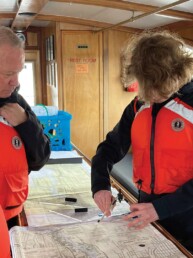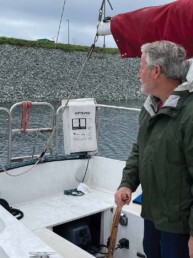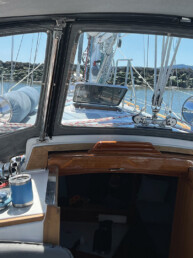Thanks to Three Sheets reader Allen Gibbard for sending this great tip…
You’ve had a fun day on the water. The cruising Gods have smiled upon you — the last mooring ball is open at your favorite destination. You’re set. Tied to the buoy with no worries about anchor slippage, you’re free to enjoy an evening of good food, some adult beverages, great conversation, maybe a kiss goodnight followed by uninterrupted sleep. Then, just as you’re drifting off to dreamland it begins … irregular hammer-like banging on the hull seemingly inches away from your head.
The first time this happens your mind goes down a list of potential causes until it’s discovered that mooring ball you were so comforted to be secured to, is now bouncing off your boat’s hull and driving everyone onboard insane. In my experience, this is most likely to occur in protected locations where currents swirl. Instead of being pulled away from the buoy by a steady current, your boat and the buoy are dancing while tied together and sometimes they collide. We’ve all experienced this. It’s awful.
What to do? Those with lengthy bowsprits have some success pulling the buoy chain up tight. This can sometimes keep the buoy away from the hull. A quick web search reveals numerous methods using combinations of boat hooks, PVC pipe and lines extended in a “V” shape in front of the boat to accomplish the same thing. To me, they all appear too complicated to be practical. Plus, the movement of that harness around the bow would itself be noisy. Instead, I’ve found an easy and cheap solution that works in most situations, at least with the new uniform Washington State Parks buoys.
Visit your favorite bicycle shop and purchase a 26” x 4.00 sand tire tube. Dig around the garage until you find the old tire pump you tucked away years ago. Grab a scrap length of line (more on that later). Toss them into a small bag along with a metal tube cap

Then, when you find yourself tied to a buoy without steady current, get out the bag and do this:
Use the pump to inflate the tube. Inflate it enough so the inner diameter fits TIGHTLY around the buoy at the indented blue line. Before placing it around the buoy, tie the scrap piece of line around the tube. How you place the tube around the buoy is up to you. I’ve found it easiest to thread the mooring line one side at a time through the tube after the mooring line has been initially secured. Once the mooring line is threaded through the tube, either push it it place with a boat hook leaning over the bow, or pull it in place from your dinghy before heading to shore the first time.

When it comes time to leave, after the mooring line is pulled from the buoy ring, simply grab the line attached to the tube with a boat hook and lift it onboard. Use the metal tube stem cap to loosen tube valve stem speeding tube deflation, tighten the valve stem when flat, put everything back in the bag for use the next time. Easy peasy and cheap. Works for me – see if it works for you.






